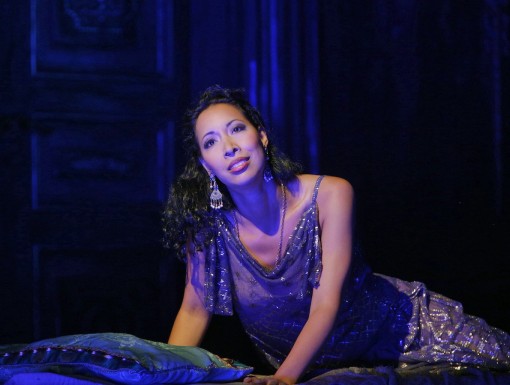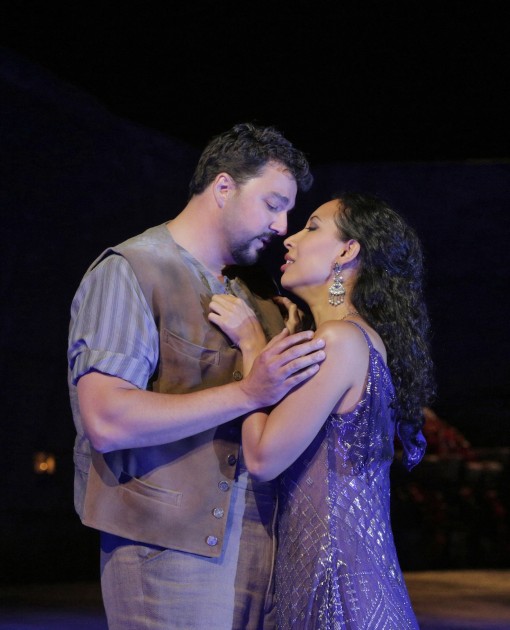Santa Fe Opera’s superb cast proves golden in “Pearl Fishers”
There are a myriad of reasons why The Pearl Fishers is a problematic work. The tale of the friends, Nadir and Zurga whose close bond is tested by their love for the priestess Leila is slight, the setting in a Ceylon fishing village has a whiff of musty, 19th century Eurocentric Orientalism, and the score lacks the sophistication and depth of characterization that Georges Bizet would soon unveil to the world with Carmen.
And yet there are also good reasons why Pearl Fishers has moved from the fringes of semi-obscurity to somewhat greater prominence in the repertory. There is Bizet’s warm melodic gift — even in journeyman form — manifested in the most beautiful duet for tenor and baritone in the literature, a pair of equally fetching arias for Leila and Nadir, several rousing choruses, and a message of duty and self-sacrifice that seems more timely than ever. And, more practically, in this era of economic nonplenty, an opera that only requires three principals and a chorus is not to be sneezed at.
Santa Fe Opera is presenting its first performances of Bizet’s tale of love among the seaweed this season. And while not everything worked Tuesday night, a superb trio of principals and an intelligent, evocative production made a strong case for this strange yet endearing work.
Nicole Cabell was born to sing the role of Leila. Her charismatic presence proved ideal for the mysterious priestess whose exotic beauty sparks turmoil between Nadir and Zurga. Dramatically she charted the role’s changes with fine insight, from remote icon, to romantic object and angry defender of her condemned lover.
Vocally, Cabell’s pure, flexible soprano was balm for the ears, bringing an airy, graceful lightness to the sinuous lines and ardent passion to her love duets with Nadir. The clear highlight of the evening was Leila’s Act 2 cavatina, rendered with glowing tone, delicate shading and extraordinary depth of feeling. Cabell sings from the heart and with that gorgeous voice, carries us right along with her.
Her male costars, by comparison, seemed to take awhile to find their footing. The celebrated duet Au fond du temple saint — a leitmotiv throughout the opera — was stronger on muscular projection than Gallic elegance.
As Leila’s secret lover, Eric Cutler’s Nadir was just as vividly characterized as Cabell’s Leila, his high tenor blending winningly with Cabell in their duets. Cutler’s Je crois encore entendre could have used a lighter touch and more fluid legato but the tenor’s sweet top notes and control were beyond reproach.
Christopher Magiera took time to warm up Tuesday but soon provided worthy singing and keen dramatic point as Zurga. He conveyed the conflicted leader — torn between his love for Leila, friendship with Nadir, and duty to the village — with natural understated acting and wielded his dark baritone with finesse in his Act 3 aria
Director Lee Blakeley’s staging, subtly updated to the time of the opera’s composition, was faultless throughout the first two acts, faithful to the scenario with several inspired touches: Leila’s early entrance as a silent veiled figure as the men sing of her in the duet; sensitive, natural movements for the singers during their set pieces; and semi-stylized gestures for the chorus that underlined the exotic locale.
Blakeley seemed to lose the thread in Act 3. The moving end of the opera where Zurga forgives Leila and Nadir, and torches the village allowing them to escape, was rushed and felt hollow, barely making an impact.
Worse still was having Leila use her feminine wiles to try to seduce Zurga into saving her lover, which only cheapens the character, making her seem merely venal and manipulative. And while Leila’s righteous anger at Zurga for condemning the lovers is there, having her spit in Zurga’s face clanged dissonantly against the role and the tone of the opera. What kind of high priestess suddenly turns into a slatternly, spiteful Carmen of Ceylon?
Designer Jean-Marc Puissant’s scenic stone ruins gently nudged the action to the 19th century with a significant assist from Rick Fisher’s painterly lighting. The gleaming gold frame that sets off the action tilts precariously forward when the love triangle threatens the village’s peace, righting itself again with Zurga’s unselfish act at the close. Only the massive open hand for the funeral pyre seemed ll-advised, suggesting a Palmolive commercial.
Nadir’s Indiana Jones getup at his entrance looked anachronistic, but otherwise Brigitte Reiffenstuel’s costumes offered fine contrast, with Leila’s colorful flowing veils and gowns set against the drab earth tones of the villagers.
Wayne Tigges brought a robust bass and commanding presence to the Brahmin high priest Nourabad. The chorus is the fourth major character in this work and, under Susanne Sheston’s direction, the ensemble delivered, singing with vital and refined corporate vigor.
Emmanuel Villaume displayed his considerable bona fides in French repertoire once again, conducting a performance that conveyed the melodic richness of Bizet’s music with elegance, delicacy and dramatic point as needed.
The Pearl Fishers runs through August 25. santafeopera.org

